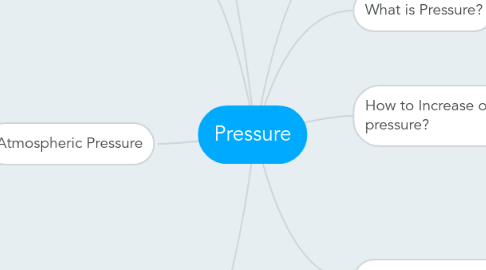
1. How to calculate pressure
1.1. Pressure = Force/Area
1.1.1. How to calculate Area
1.1.1.1. Area = Force/Pressure
1.1.1.1.1. Area is measured in metres or in centimetres
1.1.2. How to calculate Force
1.1.2.1. Force = Pressure x Area
1.1.2.1.1. Force is measured in Newtons
2. Pressure Difference
2.1. Manometer
2.1.1. It is made from a U-shaped tube of liquid in which the difference in pressure acting on the two straight sections of the tube causes the liquid to reach different heights in the two arms.
2.1.2. A manometer measures the pressure acting on a column of fluid
3. Atmospheric Pressure
3.1. The weight of air resting on the Earth's surface
3.2. Barometer
3.2.1. An instrument measuring atmospheric pressure, used especially in forecasting the weather and determining altitude.
3.2.2. higher atmospheric pressure exerts a downward force on the mercury in the reservoir - and pushes the mercury up the tube
3.2.3. lower atmospheric pressure cannot hold up the weight of the mercury column as effectively - so the mercury moves lower down the tube
3.3. 1 atm = 100000Pa or 100kPa
4. Depth and Pressure in liquids
4.1. Pressure increases with depth
4.2. Pressure does not depend on the shape of the container
4.3. Pressure depends on the density of the liquid
4.4. Pressure acts in all directions
4.5. Pressure can be calculated using the following formula
4.5.1. P = pgh
5. Units
5.1. Pascal
5.1.1. 1000Pa = 1kPa
5.2. Newtons per metre squared
5.2.1. N/m²
6. What is Pressure?
6.1. Pressure is an expression of force exerted on a surface per unit area
7. How to Increase or reduce pressure?
7.1. Increase
7.1.1. Reducing surface area
7.1.2. Applying a larger force
7.2. Reduce
7.2.1. Increasing surface area
7.2.2. Applying a smaller force
8. Gas Pressure and volume
8.1. When dealing with a fixed mass of gas there are 3 factors to consider
8.1.1. A change in one of these factors produces a change in at least one of the others
8.1.1.1. Temperature
8.1.1.2. Pressure
8.1.1.3. Volume
8.2. For a fixed mass of gas at constant temperature, the pressure is inversely proportional to the volume (Boyle's law)
8.2.1. If the volume halves, the pressure doubles
8.2.2. P1 x V1 = P2 x V2

